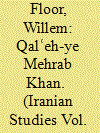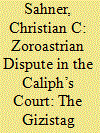|
|
|
Sort Order |
|
|
|
Items / Page
|
|
|
|
|
|
|
| Srl | Item |
| 1 |
ID:
171088


|
|
|
|
|
| Summary/Abstract |
Before discussing the establishment and functioning of the first real leprosarium in Iran, a brief explanation is given of the pathology of leprosy, the various names are listed under which it was known in Persian, and the earliest archeological evidence of its occurrence is presented. Also, societal behavior in Imperial Iran towards lepers is highlighted, while reference is made to the earliest medical descriptions of leprosy in Persian. Little is known about the occurrence of leprosy in Iran over the centuries, as evidenced by the lack of knowledge about its prevalence among medical practitioners and institutions in Iran, even as late as the 1920s. Although segregated villages with lepers existed prior to 1926, it was only as of then that the Mehrab Khan village became the first true Iranian leprosarium, when regular institutional medical treatment was offered by American missionary physicians. The funding agencies, medical personnel and treatment, the living environment of lepers and their numbers in Mehrab Khan are discussed as well as how its population size and status changed over time, and how it was transformed into a structural component of public medical care. Finally and briefly, the establishment and functioning of two other Iranian leprosaria is discussed as well as the slow but sure disappearance of the disease in Iran.
|
|
|
|
|
|
|
|
|
|
|
|
|
|
|
|
| 2 |
ID:
165990


|
|
|
|
|
| Summary/Abstract |
The Palestine Group was a loosely connected collection of young anti-Shah activists some of whom were arrested and tried publically in 1970 for the crime of acting against the Pahlavi monarchy and Iran's national security. Their plight became global, receiving support from anticolonial figures such as Jean-Paul Sartre. But while they played an important role in inspiring the revolutionary generation, in the historiography of the 1979 revolution and that of the global south, their story has been mostly forgotten. This article argues for remembering the Palestine Group by focusing on two facets of their prerevolutionary activism: the importance of a connection to the anti-imperial/colonial struggles that spread from “Asia to Africa”; and the centrality of maḥfilī politics (friendship circles) in addition to tashkīlātī (organizational) politics, which the historiography has traditionally emphasized. It demonstrates that as resistance shifted from maḥfil to tashkīlāt, it also shifted from a global struggle where Iran was one node out of many, to a nationalized struggle.
|
|
|
|
|
|
|
|
|
|
|
|
|
|
|
|
| 3 |
ID:
165770


|
|
|
|
|
| Summary/Abstract |
The Gizistag Abāliš is a ninth- or tenth-century Pahlavi text, recording a debate which took place at the court of al-Maʾmūn between a Zoroastrian priest and a heretical dualist. This article, the first in-depth study of this important work, examines the text in its broader Islamicate environment. It argues that the narrative itself is probably fictional, but reflects a real historical phenomenon, namely the interreligious debates which took place among Zoroastrians, Muslims, Christians, and Jews during the ʿAbbasid period. It argues that the text is a unique Zoroastrian example of a literary genre that was common among Christians at the time, namely, “the monk in the emir’s majlis.” By comparing the Gizistag Abāliš to these Christian texts, it explores why Zoroastrians generally did not launch explicit polemics against Islam, comparable to those of other non-Muslim communities. It seems that Zoroastrian authors were more concerned with explaining their own doctrines than critiquing the beliefs of others. This is curious considering the large numbers of Zoroastrians who were converting to Islam at the time. Finally, the article proposes new ways of refining the way we read Pahlavi texts, by analyzing them alongside the literatures of other religious communities in the early Islamic empire.
|
|
|
|
|
|
|
|
|
|
|
|
|
|
|
|
|
|
|
|
|